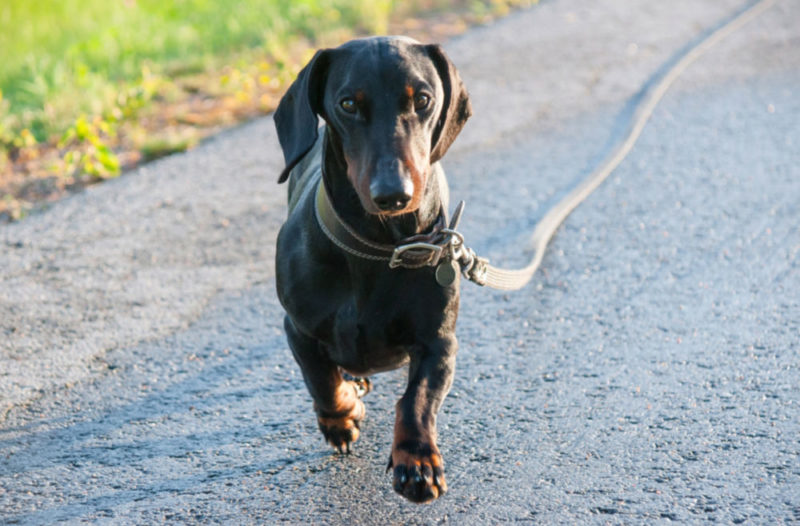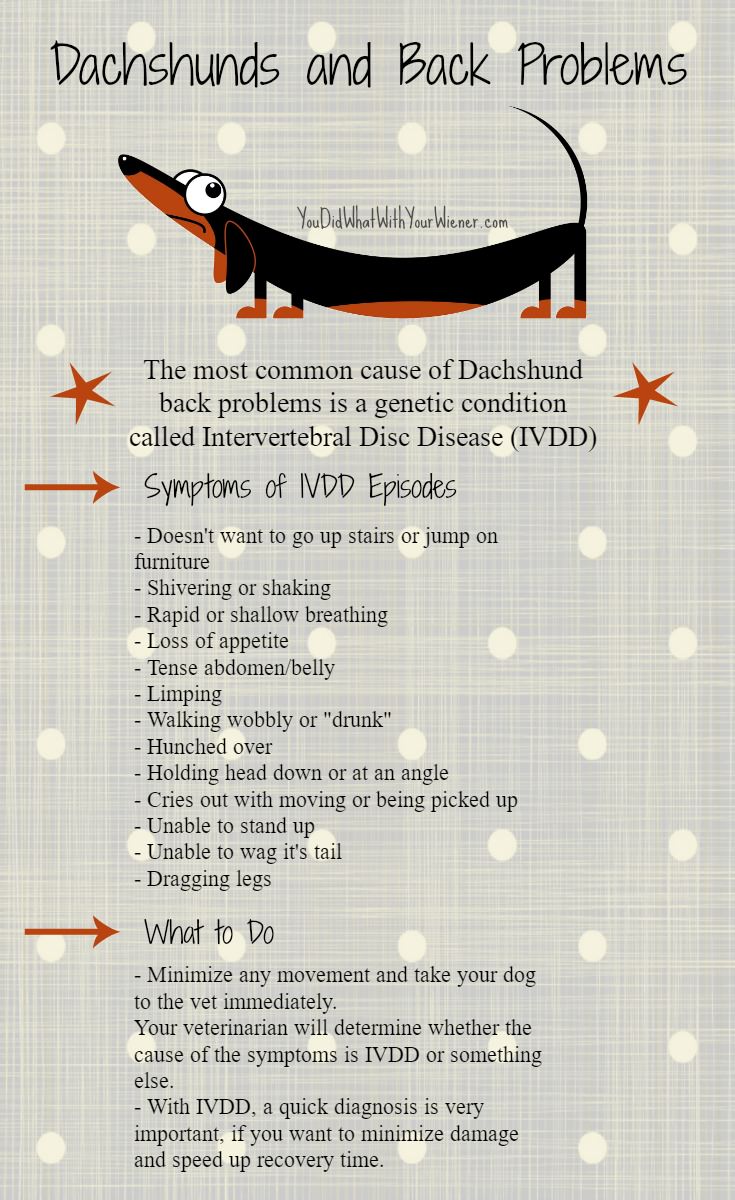Debunking Myths About Dachshunds and Exercise
As you know if you’re read my blog at all, I am very passionate about making sure a Dachshund gets enough exercise.
There are two main reasons for this:
- It helps to keep them healthy and fit
- It helps keep their core and back muscles strong so they are less likely to suffer from a back injury (or, as in our case, it was more mild and can recover faster)
Over the years, I’ve found that people often get a Dachshund- a small dog – because they think their size means they won’t need much exercise.
However, that is far from the truth.
Can a Dachshund learn to be lazy? Sure. But that doesn’t mean they should be.
There is mounting evidence for keeping a Dachshund fit and strong to help reduce the incidents of back and spine injury.
UPDATED: February 7, 2023

Dachshunds were bred as hunting dogs and many are capable of the same amount of exercise as most bigger dogs.
Today, I want to debunk some of the myths about Dachshunds and exercise and answer the question:
“What’s the minimum amount of exercise required to help keep a Dachshund’s back, and spine-supporting muscles, strong?”
General Guidelines for Exercise for Dachshunds
When it comes to exercise, each dog is different in their ability and interest.
However, as with people, there are some minimum activity guidelines.
Generally, a healthy, adult dog needs at least 30 minutes of activity a day.
Some dogs need a lot more in order to be happily tired.
While Dachshunds, a hunting breed with a lot of natural energy, are definitely capable of doing more than 30 minutes a day, based on experience, I would say that is an acceptable minimum.
However, my Dachshunds – and I’ve seen many who can do the same – can easily hike or walk for 1-2 hours a day or more.
In fact, my dogs are so used to exercising for longer they can hike up a steep hill for 4 or 5 hours and still have energy to sprint back to the car.
Of course, puppies, senior dogs, and dogs with health issues may need less exercise or be incapable of doing that much.
The general exercise rule for puppies is 5 minutes of activity for every month of age, up to twice a day.
Most senior dogs still need at least 30 minutes of exercise a day but they may need that broken up into 2-3 sessions a day and to go at a slower pace.
How is Exercise related to Back Injuries?
There is definitely a correlation between exercise and Dachshund back problems but they are probably not related in the way you might think.
Some owners are under the impression that their Dachshund’s backs are very fragile, so keeping them less active reduces the risk of injury.
Even if the owner is very active, they often leave their Dachshund at home when going for a long walk or hike.
Also, the internet is plastered with warnings such as:
- Never let your Dachshund use stairs
- Never let your Dachshund jump up or off of anything
- Dachshund’s can’t do sports like agility, dock diving, or flyball
It turns out that completely eliminating these things from a Dachshunds life can’t prevent back injuries and, in some cases, may indirectly make a back injury worse.
What Causes Back Problems in Dachshunds?

With their long backs and short little legs – which creates a longer span between the spine supporting legs – it might make sense to you that Dachshunds would suffer from problems with their backs.
However, a Dachshund’s propensity for back injury is not more complicated than that.
More specifically, the long and short proportions of a Dachshund are caused by the dwarfism gene.
This gene is associated with a higher rate of Chondrodystrophy and Intervertebral Disc Disease (IVDD).
IVDD causes a Dachshund’s spine to age prematurely and for the disks between the vertebrae to become brittle.
When one of these disks cracks or “explodes”, material from inside the disk can put pressure on, and damage, spinal nerves.
Depending on where this happens along the spine, and to what degree, this can result in pain, lameness, or paralysis in the back legs or both the back and front legs.
In other words, most Dachshund back injuries are caused by genetics, not because of their long backs.
However, the frequency and severity of disk ruptures are also influenced by lifestyle factors, including exercise.
Debunking Common Myths About Dachshunds and Exercise
The increased tendency of Dachshunds to suffer from IVDD-related back injuries compared to other dog breeds is a known one.
Unfortunately, this has led to some misconceptions about exercise and activity restrictions that should be put on Dachshunds to purportedly protect their backs from injury.
The vast majority of websites, including some maintained by qualified veterinarians, will tell you that the way to protect a Dachshund’s delicate spine is to strictly prohibit them from climbing up on or jumping down from furniture.
Similarly, Dachshund owners are usually encouraged to avoid letting their Dachshund use stairs.
Owners are encouraged to install ramps to allow their Dachshund to get on and off furniture.
It is also commonly assumed that Dachshunds have low to moderate energy levels and that their daily physical needs can be met by following their owners around the house.
The final, most prevalent, piece of advice regarding the care and protection of a Dachshund’s spine is to ensure that the dog is always held in a way that supports the back.
People are advised to keep the Dachshund’s body in a horizontal position while being held, with one arm supporting the rear end and the other supporting the chest.
One of the above pieces of advice is actually both correct and helpful to a Dachshund’s back. Can you guess which one?
Your choices are:
- Prohibit Dachshunds from jumping up or down from furniture
- Prohibit Dachshunds from using stairs
- Dachshunds have low to moderate energy levels and shouldn’t exercise too much
- Dachshunds should be carried in a well-supported horizontal position.
See below for the correct answer.

Misconceptions About Activity and Back Injuries – What the Science Says
If you guessed that number four is the correct piece of advice, you’re absolutely right.
Dachshunds should be carefully carried in horizontal position with both their chest and rear firmly and equally supported.
This means that the first three pieces of advice might be incorrect.
But how can this be so, with so many sources insisting that they are true?
Let’s defer to the experts here and cite an extensive 2015 study on Dachshunds, published in Canine Genetics and Epidemiology (2016, Volume 3, Number 1, Page 1).
This study involved an in-depth study of the risk factors of Dachshunds suffering from IVDD.
It included the effects of furniture jumping, stair access, and exercise on the likelihood that a Dachshund will be diagnosed with IVDD during their lifespan.
Without getting into the statistics and the rigorous methods used when compiling the study (you can read that by clicking the link above), let’s jump straight to the results and how they relate to the three misconceptions identified above.
Note: While the DachsLife 2015 survey is one that is very respected in the Dachshund community, and the results are very revealing, it does have limits.
Even the creators admit that correlation does not mean causation – that just because two things happen together does not mean one is causing the other.
However, the study did reveal new information that should be explored further.
Dachshunds Should Never Jump
List item #1: Prohibit Dachshunds from jumping up or down from furniture.
Study Conclusion
Dachshunds who were not allowed to jump up or down from furniture were found to be at greater risk of suffering from IVDD.
It’s thought that dogs who regularly jump up and down, and between items of furniture may gradually, develop spinal musculature, natural protection against IVDD.
Commentary: the study didn’t define height of jump but it’s assumed they didn’t mean jumping more than a foot or two.

Dachshunds Should Not Use Stairs
List item #2: Prohibit Dachshunds from using stairs
Study Conclusion
Dachshunds who did not use stairs at all, or who used a maximum of one step in or out of the house each day, were found to be at an increased risk of being diagnosed with IVDD.
You can read more about Dachshunds using stairs HERE.
Commentary: Gretel’s rehab vet told us that stairs were ok and maybe even good – especially going up – because it can help strengthen their core (as long as they were not going to likely fall and twist going up or down)
Dachshunds Shouldn’t Get Too Much Exercise
List item#3: Dachshunds have low to moderate energy levels and shouldn’t exercise too much
Study Conclusion
Dachshunds who were exercised for less than 30 minutes a day had an increased risk of IVDD-related back injuries.
Dogs considered to be moderately or highly active were considerably less likely to suffer from IVDD-related back injuries.
One hour per day of deliberate exercise was considered sufficient to meet the natural energy requirements of a Dachshund, while taking positive steps to reduce the risk of IVDD.
Commentary: I’ve found that 45-60 minutes a day is the ideal minimum exercise for my own Dachshunds in order to tire them out and make them happy

So What Can You Do To Help Reduce the Chance of Your Dachshund Injuring Their Back?
Below are some of the lifestyle factors associated with disk herniations due to IVDD.
1) Exercise Your Dachshund
People who have a Dachshund as a pet understandably want to do everything they can to increase their beloved dog’s health, happiness, and life expectancy.
This includes – and may be the predominant concern given that 25% of Dachshunds will have back issues in their lifetime – wanting to protect their Dachshund’s back from injury.
It is perfectly understandable, then, why many people follow the common, yet ill-advised, online advice warning against overexerting a Dachshund, or letting them climb stairs or jump up on furniture, for fear of hurting their back.
That’s the advice you most commonly see repeated around the internet. But saying something over and over again doesn’t make it true.
Unfortunately, people who follow this type of advice may be inadvertently doing a grave disservice to their dog.
Yes, it is important to protect the relatively fragile overly long back of a Dachshund, but limiting their activity is not the way to do this.
As we now know, one of the best things you can do to prevent a back injury in your Dachshunds is to provide a moderate amount of daily exercise – ideally at least 30-60 a day.
In addition, according to this study, there is likely a benefit from allowing your Dachshund to climb stairs and jump onto and between items of furniture.
2) Know the Signs and Symptoms of IVDD
The very best thing you can do to help prevent debilitating back injuries in your Dachshund is to commit the signs and symptoms of an IVDD disk rupture to memory.
In fact, this is doubly important if your Dachshund is active.
Symptoms of an IVDD-related injury can start with pain, discomfort, and stiffness, and can move to the inability to rise up and “stand” on the rear legs, loss of bladder and bowel control, and even complete paralysis.
Nobody wants that for their pet.
Some IVDD injuries are sudden and severe. In those cases, there were probably no warning signs for you to spot.
However, many others start with small signs (you won’t catch unless you really know what to look for) before progressing to a full disk rupture.
So what are the signs and symptoms that could mean your dog is suffering from an IVDD-related injury?
The most common are:
- Walking wobbly or “drunk”
- Standing with their back hunched
- Showing signs of pain like shivering, rapid breathing, hiding in a corner or den (like crate or nook), and refusing to eat
- Yelping or crying out if you touch them
- suddenly paralyzed or not able to stand

If you notice any of these in your dog, please call your vet right away and make an appointment.
In the meantime, you must do this to help make sure the issue doesn’t get worse.
Final Thoughts
The increased tendency of Dachshunds to suffer from IVDD-related back injuries compared to other dog breeds is a known one.
Because of this, the Dachshund breed is considered one of the most likely to end up needing the use of a canine wheelchair to support the back legs in later life.
However, limiting a healthy Dachshund’s activity level, and types of activity, is unlikely to prevent back injuries.
In fact, this study, and some others out there, found that doing so may make the frequency and severity of spinal injuries in Dachshunds worse.
In most of the stories about Dachshunds who suffer an IVDD-related spinal injury and are partially or fully paralyzed, the owner could not point to a direct cause.
They describe their Dachshund being fine one minute and being unable to walk the next.
While it is true that jumping and exercise may need to be limited in a dog with a history of back issues, assuming all Dachshunds need their activities limited is generally unnecessary.
As always, stay in touch with your veterinarian to regularly monitor the health, fitness, and well-being of your dog.
In the meantime, make the most of life with your courageous, bold, and short-statured fiery Dachshund.
Note: This article has been updated by me but the original article was provided by James Woller, co-owner of Jet Pet Resort and Release the Hounds, professional dog service companies based in Vancouver, Canada, and executive director of the Thrive For Good non-profit.


About the Author
Hi, I’m Jessica. I’ve been studying the Dachshund breed since 2007, owned 3 of my own, and shared in the lives of thousands of others through their owner’s stories. When I’m not sharing what I know on this blog, you can find me hiking, camping, and traveling with my adventurous wiener dogs.

My Vet told me about this site. I love it.
I am 67 yrs. young, and I have had dachshunds since I was 14. All of them were standard, and lived 20 + years. Exercise is necessary for quality of life dogs as well as humans. Get one!
.
Woe. How wonderful to have shared your life with Dachshunds for so long. They certainly are special little dogs 🙂
I read the article and was amazed to know that they can jump up and down from my bed. I was under the impression that not let my dogs jump was good for them. Now I know not to stop him, he loves the stairs to the house. And walks he gets a lot of them everyday. I’ve learned so much more by reading this article. Thank you so much for the information that was provided.
Personally, I would not let my Dachshunds jump from a standard bed height. Most are well over two feet high. Furniture that is 15-18 inches high on occasion for me though. I allow them to jump off the window perch that is that high but not the couch, which is also that high. To me, the idea is to allow it sometimes when it’s not very high but not for them to overdo it. Stairs are always ok to me.
I have an 8 month and a 2 year old miniature dachshund. They chase each other and wrestle daily. Is this dangerous play for their backs? They use stairs but sometimes jump off the couch when excited.
Hi Joan. I would definitely prevent or greatly minimize jumping off the furniture. Here is an article on my other Dachshund blog that can help with that. https://formydachshund.com/how-to-prevent-your-dachshund-from-jumping-on-and-off-furniture/. The chasing and wrestling is ok but I would always stay vigilant about watching after to make sure one isn’t limping. If one is trying to get away from the other, personally, I would give them each a time out. One dog may “play” beyond when they are tired or sore simply out of defense. If it seems pretty even and fair though, it should be fine.
This was a good and easy to read article. It reminded me of my Dachshund. He was always so precarious, getting into everything. One time he chewed completely through the cage when I left him at home. At that point I got a pet sitter but it was okay. He was the best dog ever!
We have bought a ramp for my miniature dachshund. He loves to play by running up and down it after a doggy toy is thrown is this ok for him. I was also told that providing you put your hand under his bottom it was ok to carry him vertically. She is only 5 months old Please can you help.
Hi Irene. Yes, as long as the back end is supported, carrying them vertically is ok. Horizontal is ideal but not always practical. Running up and down the ramp should be find as long as he actually runs the whole thing and doesn’t jump off the side half way down.
I have my 4th dachshund. He’s just a year. Got him from a very good breeder. All my other ones were fine. Never suffered back issues. We have a bi-level house, so stairs all the time. He’s on the BARF diet, which I feel is a very good diet. He gets long walks. He has great muscle tone in his hind legs. Will he be OK with the stairs?
Hi Kathy. I asked our rehab vet (when Gretel had her back injury) and she did not strictly advise against stairs. She even speculated there could be some benefit in regard to strentgh. However, she did point out that stairs were ok a long as there was little or no risk of a Dachshund falling off, or down them, and twisting their spine. And, based on my experience and comfort level, I don’t allow my dogs to go down stairs that are taller than they are long so they can actually step down instead of jump (I’m not worried about up unless it’s so tall they might not make it and fall).
This well-researched article has been off immense support to me. I started off with ramps everywhere and carrying Misty ( now 10 months old) up and down stairs – this didn’t last as Misty loves running up the stairs and flinging herself off the furniture . She laughs in the face of ramps! I have always carried her by supporting her bum, but now realise she needs to be carried horizontally and will do so from now on. IVDD is a constant worry- but I now feel much less anxious about my fearless, flying pup. Thank you.
Hi Hilary. I still don’t recommend “flying off furniture”, especially for puppies when their joints are still forming, but smaller jumps are ok (my rule is as tall as they are long). The jumping is hard on other joints/ligaments and could cause something like an ACL tear. Personally, I had a decision to make to keep my Dachshunds from jumping off the couch – not let them on unless I was there or to put up fences around it so the only way on/off was the ramp. I chose the latter. It’s not pretty, but it works. With that being said, in regard to back issues, a few jumps off of furniture now and then isn’t anything to panic about.